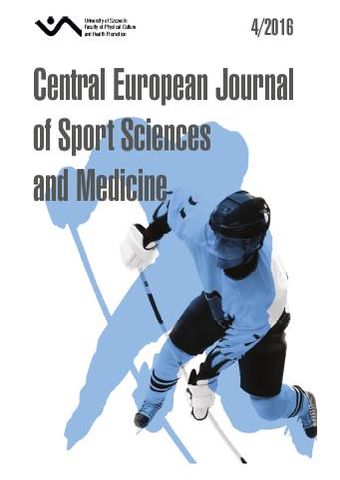
ISSN: 2300-9705
eISSN: 2353-2807
OAI
DOI: 10.18276/cej.2016.4-11




Lista wydań /
Vol. 16, No. 4/2016
Maximum Locomotor Speed of the Best Football Players at the FIFA World Cup in Brazil
| Autorzy: |
Łukasz
Bojkowski
Division of Physical Activity and Health Promotion Science, University School of Physical Education, Poznań, Poland Robert Śliwowski Division of Theory and Methodology of Team Sport Games, University School of Physical Education, Poznań, Poland Andrzej Wieczorek Division of Theory and Methodology of Team Sport Games, University School of Physical Education, Poznań, Poland |
| Słowa kluczowe: | World Cup football speed |
| Data publikacji całości: | 2016 |
| Liczba stron: | 8 (103-110) |
Abstrakt
In comprehensive preparation of a player to football competition special attention is paid to his predispositions in terms of speed abilities. Therefore, the authors’ objective was to analyse maximum locomotor speed of players of the four best national teams competing during the FIFA World Cup in Brazil, including specifying the differences in terms of speeds of these national teams and players in corresponding playing positions of individual teams. The analysis used data obtained using the Castrol Performance Index, a kinematic method and in order to present significance of differences between the studied teams and playing positions one-way analysis of variance (ANOVA) was performed. The study showed that the mean maximum running speed of the players of the four best teams of the World Cup was 8.34 metres/ second. The mean maximum locomotive speed of the defenders in semi-finalist teams of the tournament was 8.29 m/s, while the midfielders’ speed was – 8.16 m/s, the forwards’ – 8.48 m/s and the goalkeepers’ – 7.40 m/s. The players who had a maximum speed of 9 m/s or more were the Dutchman Ron Vlaar (9.16 m/s) and the Argentines José María Basanta (9.09 m/s) and Ángel Di Maria (9.17 m/s). There is no significant difference between the world’s best teams, including between their corresponding playing positions, in the level of maximum running speeds determining the dynamics of the game.
Pobierz plik
Plik artykułu
Bibliografia
| 1. | Bangsbo, J., Lorregaard, L., Thorsoe, F. (1991). Activity profile of competition soccer. Can J Sports Sci., 16 (2), 110–116. |
| 2. | Bangsbo, J. (1999). Sprawność fizyczna piłkarza: naukowe podstawy treningu. Warszawa: COS. |
| 3. | Bompa, T., Zając A., Waśkiewicz, Z., Chmura, J. (2013). Przygotowanie sprawnościowe w zespołowych grach sportowych. Katowice: AWF. |
| 4. | Bradley, P.S., Sheldon, W., Wooster, B. Olsen, P., Boanas, P., Krustrup, P. (2009). High-intensity running in English FA Premier League soccer matches. Journal of Sports Sciences, 27 (2), 159–168. |
| 5. | Chmura, J. (2001). Szybkość w piłce nożnej. Katowice: AWF. |
| 6. | Chmura, P., Chmura, J., Kawczyński, A., Mroczek, D. (2010). Szybkościowe formy aktywności ruchowej piłkarzy na Mistrzostwach Świata w Piłce Nożnej 2010. Sport Wyczynowy, 4 (536), 80–87. |
| 7. | Chmura, P., Goliński, D., Andrzejewski, M., Mroczek, D., Kawczyński, A., Rokita, A., Chmura, J. (2014). Endurance capacity and selected technical-tactical skills of soccer players participating in the group stage of the 2014 FIFA World Cup. Trends in Sport Sciences, 3 (21), 153–160. |
| 8. | Cometti, G., Maffiuletti, N.A., Pousson, M., Chatard, J.C., Maffulli, N. (2001). Isokinetic Strength and Anaerobic Power of Elite, Subelite and Amateur French Soccer Players. Int J Sports Med., 22, 45–51. |
| 9. | Dargiewicz, R., Jastrzębski, Z. (2012). Kinematyka lokomocji piłkarzy nożnych na różnych etapach przygotowań. Gdańsk: AWFiS. |
| 10. | Dellal, A., Chamari, K., Wong, D.P., Ahmaidi, S., Keller, D., Barros, R.M.L., Bisciotti, G.N., Carling, Ch. (2011). Comparison of physical and technical performance in European soccer match-play: FA Premier League and La Liga. European Journal of Sport Science, 11 (1), 51–59. |
| 11. | Di Salvo, V., Baron, R., Tschan, H., Calderon Montero, F.J., Bachl, N., Pigozzi, F. (2007). Performance characteristic according to playing position in elite soccer. International Journal & Sports Medicine, 3, 222–227. |
| 12. | Faude, O., Koch, T., Meyer, T. (2012). Straight sprinting is the most frequent action in goal situations in professional football. J Sport Sci., 30, 625–631. |
| 13. | Ferro, A., Villacieros, J., Floría, P., Graupera, J.L. (2014). Analysis of Speed Performance In Soccer by a Playing Position and a Sports Level Using a Laser System. Journal of Human Kinetics, 44, 143–153. |
| 14. | Lago, C., Casais, L., Dominguez, E., Sampaio, J. (2010). The effects of situational variables on distance covered at various speeds in elite soccer. European Journal of Sport Science March., 10 (2), 103–107. |
| 15. | Mohr, M., Krustrup, P., Bangsbo, J. (2003). Match performance of high-standard soccer players with special reference to development of fatigue. Journal of Sports Sciences, 21, 519–528. |